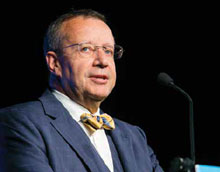In the Trenches
E-stonia Takes Off
Toomas Hendrik Ilves explains how digitalization can make people’s lives a whole lot easier

Toomas Hendrik Ilves is the former president of Estonia and the man behind rebranding the country once best known for logging to the place where Skype was born. Inspired by his own childhood experience learning computer programming in a New Jersey high school, Ilves launched the Tiger Leap project–which involved building network infrastructure and getting schools online. It was the early 1990s; Estonia had regained its independence after the collapse of the Soviet Union, and Ilves recognized the promise of technology as a means of boosting its ailing economy.
Born in Sweden to Estonian parents who had escaped the Iron Curtain, Ilves grew up in the United States. It was while serving in Washington, DC, as Estonia’s Ambassador to the United States and Canada that Ilves laid the groundwork for the country’s digitalization program known today as e-Estonia. He was elected president of Estonia in 2006 and served two terms.
In this interview with F&D’s Bruce Edwards, Ilves says it was innovative policy more than technology that enabled Estonia’s remarkable digital transformation.
F&D: Just how digitalized has Estonian society become?
THI: There are only three transactions involving the government where you actually have to show up. The first is getting married, the second is the sale of real estate, and the third is divorce.
F&D: Are people well adapted to the system?
THI: Yes. The common gripe among Estonians abroad is that systems don’t work. After the end of my term I came to Silicon Valley, the mecca of information technology and innovation. Within a 10-mile radius are the headquarters for Apple, Facebook, Google, Tesla, and more. But when I registered my daughter for school, I had to prove that we lived in Palo Alto by bringing a photocopy of my electricity bill. So you have this enormous contrast.
We Estonians in Silicon Valley all wonder how it’s possible that this is the center of the technology universe, yet everyday life is so 1950s!
F&D: Certain aspects of digitalization are highly contested in a lot of countries because of the collection of personal data. How difficult was it to get Estonians to buy into this idea?
THI: People didn’t really object because it’s highly secure. Part of it is architectural: we don’t have any central databases. You can only access this system through a highly encrypted end-to-end, two-factor authorization system. For that, you need a secure digital identity or ID card.
F&D: On what technology is it based?
THI: You have a distributed data exchange layer, which means that only you and those people you authorize can access your data. If you authorize a doctor, only that doctor can see your medical data. And every time someone accesses the data, the system flags it. This is how people know they’d get caught if they were to try.
Ultimately it is all based on trust. I can assure you that even in the most horrendous of crimes, the government of Estonia would not go into your private data because there is full recognition on the part of the government that, if the system were ever to be compromised, it would fall flat and collapse. So no one takes that risk.
F&D: But at the very beginning of the process, weren’t Estonians reluctant to share their data?
THI: Their data are stored; they’re not sharing it. Estonians like this system because it’s convenient. Your records are far more secure this way than on paper. You can, in fact, still do everything on paper. It’s just that people prefer not to.
F&D: Is the technology overwhelming for some older people?
THI: Well, we’ve been doing this for 25 years. So, if you’re 50 you were 25 when it started. You only really need to have access to a computer, be able to read, and have an ID card. So that has not been a problem. In terms of jobs, we have a 4.4 percent unemployment rate in Estonia, which is almost full employment. The future is going to be more and more technology based, of course. We see ourselves as ahead of the curve because we teach kids to program in elementary school.
F&D: The digitalization process in Estonia has spurred some interesting concepts like “e-residency,” which offers nonresidents virtual residency. What’s the benefit of becoming an e-resident?
THI: The main benefit is for small and medium-sized enterprises that want to be within the European Union. They can just set up their company in Estonia digitally. They pay taxes in Estonia, which is one benefit because the tax rates are lower.
F&D: Is this a way for the government to expand its tax base?
THI: Not really. We make a bit of money, but it’s more that it’s innovative. It makes people think differently about the role of the state and of the EU’s single market. It calls into question this idea that you have to be there physically in order to have an EU business. You don’t—businesses are already virtual in many cases. We just took it one step further.
F&D: Can you imagine a digitally integrated European Union?
THI: That was the agenda of Estonia’s EU presidency that just ended—to get the EU to move in the direction of creating the legal framework. Right now, you have free movement of labor, capital, goods, and some services. But the same free movement does not exist for digital services or data. Estonia has pushed to get those basic roadblocks removed.
Here’s an example of a cool innovation: In Estonia, we have digital prescriptions. You go see a doctor and he puts your prescription into the computer. From then on, if you want a renewal, you can go to any pharmacy in the country, insert your card, and get your medicine. Finland has basically adopted our platform. So I proposed to Finland’s president that we link the systems, as we get 8 million visits from Finland each year. Well, it has taken almost six years, but starting this summer, if you’re a Finn and you visit Estonia and need a refill from your doctor, you just call your doctor in Finland and you can go to an Estonian pharmacy. One day this may work all across Europe, but right now, this is a huge step forward.
F&D: There are so many cool aspects to this story. Why aren’t more countries doing this?
THI: I keep stressing it’s not the technology. It’s political will, policy, laws and regulations, in that order. In order for it to work, you need laws that underpin the system. You want to define digital identity, then set out the regulations to avoid abuses. And in Estonia that has worked.
This interview has been edited for length and clarity.
Small Country with a Big Backbone
Estonia’s 1.3 million citizens rarely stand in line for anything. Virtually all government services and a growing number of private sector services are offered online via its snappy e-Estonia.com state portal. It ranks among the most digitally advanced countries in the world thanks to a government-backed technology investment initiative dating back to the early 90s. Estonia has since made massive investments toward increasing its bandwidth and designing school curricula to have a “Technology and Innovation” theme. Children learn how to write code from the age of seven.
At the heart of Estonia’s digital society lies an encrypted national identification card that provides access to all of Estonia’s e-services, such as one-click tax filing, i-voting and electronic medical records. Information technology allows security services to determine the locations of accident victims more effectively and has made police work 50 times more efficient.
Estonia has also become somewhat of a hotbed for start-ups, including Skype. Its e-Residency program—which offers nonresidents virtual residency—continues to attract entrepreneurs who want to establish a company within the European Union.
PHOTO: ALAMY / KRISTOFFER TRIPPLAAR
Opinions expressed in articles and other materials are those of the authors; they do not necessarily reflect IMF policy.







